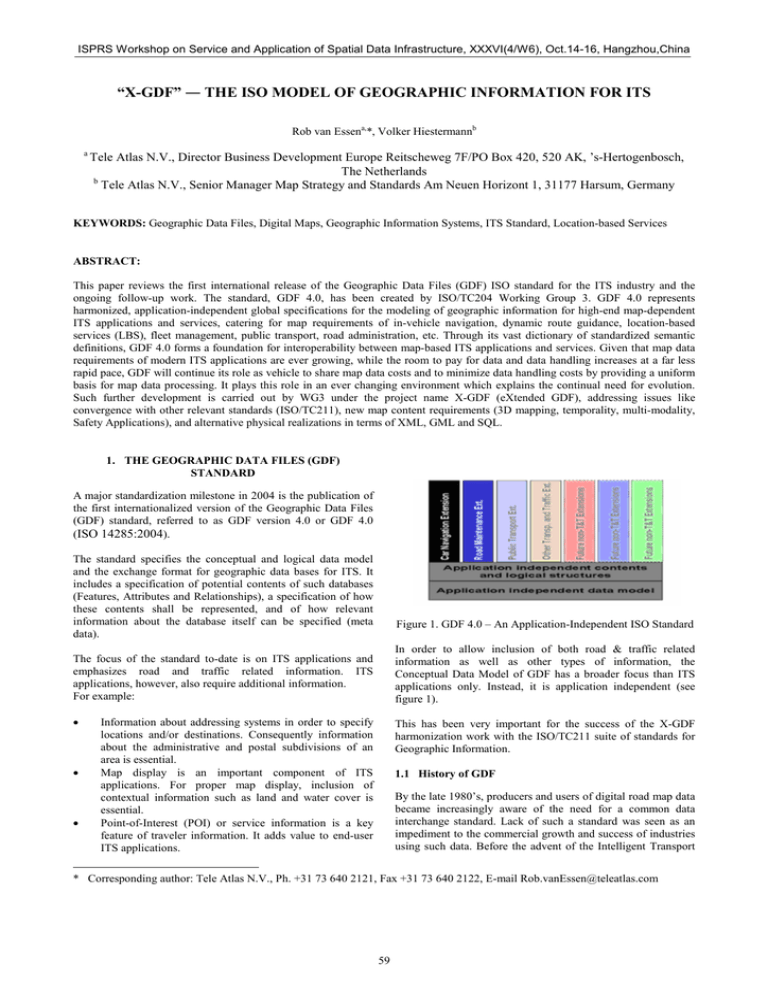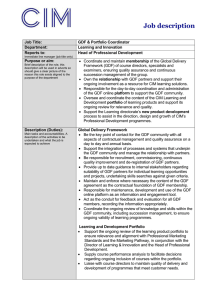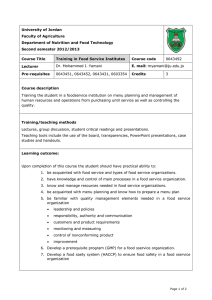ISPRS Workshop on Service and Application of Spatial Data Infrastructure,...
advertisement

ISPRS Workshop on Service and Application of Spatial Data Infrastructure, XXXVI(4/W6), Oct.14-16, Hangzhou,China “X-GDF” ― THE ISO MODEL OF GEOGRAPHIC INFORMATION FOR ITS Rob van Essena,*, Volker Hiestermannb a Tele Atlas N.V., Director Business Development Europe Reitscheweg 7F/PO Box 420, 520 AK, ’s-Hertogenbosch, The Netherlands b Tele Atlas N.V., Senior Manager Map Strategy and Standards Am Neuen Horizont 1, 31177 Harsum, Germany KEYWORDS: Geographic Data Files, Digital Maps, Geographic Information Systems, ITS Standard, Location-based Services ABSTRACT: This paper reviews the first international release of the Geographic Data Files (GDF) ISO standard for the ITS industry and the ongoing follow-up work. The standard, GDF 4.0, has been created by ISO/TC204 Working Group 3. GDF 4.0 represents harmonized, application-independent global specifications for the modeling of geographic information for high-end map-dependent ITS applications and services, catering for map requirements of in-vehicle navigation, dynamic route guidance, location-based services (LBS), fleet management, public transport, road administration, etc. Through its vast dictionary of standardized semantic definitions, GDF 4.0 forms a foundation for interoperability between map-based ITS applications and services. Given that map data requirements of modern ITS applications are ever growing, while the room to pay for data and data handling increases at a far less rapid pace, GDF will continue its role as vehicle to share map data costs and to minimize data handling costs by providing a uniform basis for map data processing. It plays this role in an ever changing environment which explains the continual need for evolution. Such further development is carried out by WG3 under the project name X-GDF (eXtended GDF), addressing issues like convergence with other relevant standards (ISO/TC211), new map content requirements (3D mapping, temporality, multi-modality, Safety Applications), and alternative physical realizations in terms of XML, GML and SQL. 1. THE GEOGRAPHIC DATA FILES (GDF) STANDARD A major standardization milestone in 2004 is the publication of the first internationalized version of the Geographic Data Files (GDF) standard, referred to as GDF version 4.0 or GDF 4.0 (ISO 14285:2004). The standard specifies the conceptual and logical data model and the exchange format for geographic data bases for ITS. It includes a specification of potential contents of such databases (Features, Attributes and Relationships), a specification of how these contents shall be represented, and of how relevant information about the database itself can be specified (meta data). Figure 1. GDF 4.0 – An Application-Independent ISO Standard In order to allow inclusion of both road & traffic related information as well as other types of information, the Conceptual Data Model of GDF has a broader focus than ITS applications only. Instead, it is application independent (see figure 1). The focus of the standard to-date is on ITS applications and emphasizes road and traffic related information. ITS applications, however, also require additional information. For example: • • • Information about addressing systems in order to specify locations and/or destinations. Consequently information about the administrative and postal subdivisions of an area is essential. Map display is an important component of ITS applications. For proper map display, inclusion of contextual information such as land and water cover is essential. Point-of-Interest (POI) or service information is a key feature of traveler information. It adds value to end-user ITS applications. This has been very important for the success of the X-GDF harmonization work with the ISO/TC211 suite of standards for Geographic Information. 1.1 History of GDF By the late 1980’s, producers and users of digital road map data became increasingly aware of the need for a common data interchange standard. Lack of such a standard was seen as an impediment to the commercial growth and success of industries using such data. Before the advent of the Intelligent Transport * Corresponding author: Tele Atlas N.V., Ph. +31 73 640 2121, Fax +31 73 640 2122, E-mail Rob.vanEssen@teleatlas.com 59 ISPRS Workshop on Service and Application of Spatial Data Infrastructure, XXXVI(4/W6), Oct.14-16, Hangzhou,China maximum flexibility as far as describing the geometric characteristics of the objects. From a computing point of view it allows for the maximum amount of database integrity guarantee and quality control. As a drawback one can mention that it includes extra overhead and the fact that the flexibility is not required for a number of applications. In order to acknowledge these facts, two additional, less complete types of topology have been included in GDF4.0: 1. Connectivity topology in which the spatial relations between the nodes (point or 0-dimensional primitive) and the edges (line or 1-dimensional primitive) are fully defined. Faces do not exist in Connectivity topology. 2. Non-explicit topology in which no spatial relations between the between the basic geometric elements are defined. A typical application which can be served by non-explicit topology is map display. Systems (ITS) industry, development of spatial data interchange standards was done mostly on a regional basis and not designed for the specialized requirements of road transport-related applications. Furthermore, the 1990s saw the expansion of the number of ITS application developers who needed map data vendors to supply their products in an economical, efficient and non-ambiguous manner. Moreover, the ITS applications suppliers and developers were largely deploying systems in Europe, Japan, or the USA, respectively, marking initially the need for standardization on a regional level. First standardization efforts therefore had a regional character. The roots of GDF were laid in Europe in the European projects Demeter, TFEDRM and EDRM2. Official standardization was continued in CEN/TC278 which resulted in the European prestandard GDF3.0 (ENV ISO/TR 14825)in 1996. A large number of stakeholders contributed to this development including navigation system vendors, map providers, car manufacturers, road authorities and public transport organizations. 2.1.2 Support of Two-Byte Character Sets: The European GDF standard was designed taking requirements of European languages into account. For these languages 1-byte character sets generally suffice. Extending the scope to include the requirements of virtually all the world languages including languages like Chinese, Japanese, Korean and Arabic introduced the need to also support the use of multi-byte character set, such as UNICODE. GDF4.0 has been extended accordingly. Globalization started in 1993 when ISO/TC204 was established. TC204 is divided into 16 working groups. Working Group 3 (WG3) was charged with the responsibility of developing standards to promote interchangeability of map data and interoperability of systems using map databases. Further development of GDF was undertaken in SWG3.1. The work of SWG3.1 started in 1994 with a review of the available regional standards documents. Considerable differences were identified. The Japanese standard developed by the Japan Digital Road Map Association (JDRMA) was oriented towards navigation applications with much emphasis placed on access speed and file size. The developments in the US had resulted in the Spatial Data Transfer Standard (SDTS), a highly generalized approach that provided a standard way of describing the contents of a geographic data set rather than on standardizing its content. GDF3.0 as developed by CEN was considered the most comprehensive model and consequently taken as a basis of the work which in the follow-up work was extended and adapted to fulfill requirements from the other regions as well as new requirements from Europe and elsewhere. 2.1.3 Enhanced (Sub-) Attribute Model: The European GDF Standard already identified the need to model attribute information in a way, which is dependent on other attribute information. For example, it was identified that the different components of house number information only had relevance in relation to each other. For this, the concept of sub-attributes had been introduced. During the ISO work it however was identified the existing model was unable to model all situations. This basic sub-attribute model has been extended in GDF4.0 towards greater expressiveness (i.e. operating scope of compositions and validity restrictions). 2.2 Content Definition Changes in GDF 2.2.1 Extension to Include Non-Hierarchical Administrative Area structures: The model, with which Administrative Areas were defined in the European GDF standard, assumed a strictly hierarchical definition. This is in accordance with reality as far as most European countries are concerned. It however is not the case for countries from an Anglo-Saxon origin. Here the definition may be far less structured. GDF4.0 is extended in such a way to also include the proper definition of these kinds of Administrative Area Structures. 2. NEW FEATURES OF THE GDF4.0 STANDARD Compared to the European GDF standard (GDF 3.0) the new ISO version has been upgraded in a multitude of ways. These can be categorized in two broad groups: Conceptual changes of the GDF core, relating to the Conceptual Data Model, Logical/Physical Data Structures & Meta Data. Content definition changes, relating to the Data Catalogues. Each of the groups stated will below be shortly elaborated. 2.2.2 Enhanced Address Model: In the European GDF standard, Address information was not defined explicitly. Only the components like street name, postal code, house number etc. were identified. This led on the one hand to ambiguities how a specific address index in an application had to be defined and on the other hand posed limitations on the creation of these indexes. ISO-GDF has been extended in such a way to meet the requirements of address indexing. 2.1 Conceptual Changes in GDF 4.0 2.1.1 Extended topological model: The objects defined in GDF have a spatial aspect. This spatial aspect has two different components, geometry (the coordinates) and topology (the spatial relations between objects). In the European GDF standard, only one type of topology was allowed, called full topology. In full topology all spatial relations between the basic geometric elements (nodes, edges and faces) are explicitly defined. Full topology allows 60 ISPRS Workshop on Service and Application of Spatial Data Infrastructure, XXXVI(4/W6), Oct.14-16, Hangzhou,China the two domains overlap and cooperating with possible shared work items, experts and common tools”. 3. NEXT GENERATION GDF: X-GDF The scope of GDF4.0 was “frozen” in 2000. Since then important developments have taken place which have led to a need for further development of GDF. These included the development of map based safety applications also referred to as Advanced Driver Assistance Systems (ADAS) and the introduction of Personal Navigation. Also the concept of Location Based Services, including Local Search had been introduced which assumed the internet as map delivery medium. Map display also showed very important developments including several types of 3D map display. Other important developments included the further development of general database technology and the realization of related Geographic Information standards like those developed in ISO/TC211. With respect to GDF important developments took place since then. The first conclusion drawn was that the differences between the two standards were relatively small. Regarding the conceptual schema language (ISO/TC211 19103), X-GDF has harmonized with TC211 by exchanging the use of NIAM for the use of UML. The data model of GDF4.0 is in the meantime completely translated into UML. Figure 2 gives the GDF overall data model in UML notation. Regarding the Spatial schema of TC211 (ISO/TC211 19107) it was concluded after intensive discussion that all topology models of GDF were supported by the TC211 spatial schema. It was also concluded that the GDF Feature, Attribute and Relationship Catalogue compliant to the TC211 Feature Cataloguing provisions (ISO/TC211 19110). Consequently, the continuation of the GDF work, called X-GDF (eXtended GDF), which started in 2001 has the following focal points: 1. Harmonization with ISO/TC211 standards. 2. Improvement of the physical record layout: a. to bring it in line with state-of-the-art database technology with particular attention for SQL (ISO/IEC 13249). b. to enable application independent interpretation of GDF data with particular attention to XML. 3. New contents requirements: a. The introduction of spatio-temporal definition of geographic objects. b. Support for safety applications. c. Support for multi-modal transport including pedestrian navigation. d. Support for 2D and 3D map display. We are now in 2005 and a long way in realizing X-GDF definitions to accommodate these requirements. The remainder of this paper will give an overview of the developments of the individual topics. Figure 2. The GDF4.0 Conceptual Model expressed in UML The majority of the work still due lies in the area of meta data. It hereby is the intention of ISO/TC204 SWG3.1 to adopt the TC211 meta data standard (ISO/TC211 19115) in favor of the independent GDF4.0 meta data catalogue, i.e. to include a TC211 reference. 3.1 Harmonization with ISO/TC211 standards TC211 works on a suite of generic standards in the field of geographic information / geomatics. This work is largely of abstract nature and traditionally undertaken by public sector organizations like national mapping authorities. These (some 40) standards set a reference framework for the realization of dedicated data models and formats for specific applications. Where for instance GDF is on the practical level defining data entities and data structures, the corresponding TC211 standards would only specify how to define such elements by offering conceptual building blocks. 3.2 Improvement of the Old Physical Realization and Creation of a Few New Ones The task of improving the physical record layout of GDF started out with the development of an XML realization of GDF. To date this has resulted in a committee draft containing a realization of the complete content of GDF4.0. In addition a report has been published describing all the design principles which have been adopted in the realization. In order to facilitate harmonization a liaison has been defined between TC204 and TC211 which has identified common areas of standardization. As a consequence of this liaison a Joint Task Force (JTF) has been installed under TC211-204 co-leadership and having members from both groups. Initially only the GDF work was identified as a field of overlap but this was later on extended to include also other areas of overlap. Since 2004, the JTF works under an ISO/TC204 – 211 Cooperative Agreement, also called the Chicago agreement. This agreement describes the purpose of the cooperation as “to establish an understanding between ISO/TC 211 and ISO/TC 204” and “to cooperate on the development of compatible standards, by identifying where Also the work on the SQL realization of GDF has progressed significantly. This work was to include two main parts: 1. The building of a relational database schema (defined in terms of SQL statements) to define the relational database table layout, including use of geometry & topology SQL/MM data types. This work has progressed to such a state that it has been finalized for all the data records. The complete realization —including meta data and headers— will be available in working draft form at the end of 2005. 2. The definition of a relational ASCII text table definition. When populated such a database would typically serve as 61 ISPRS Workshop on Service and Application of Spatial Data Infrastructure, XXXVI(4/W6), Oct.14-16, Hangzhou,China a “transport” means of the GDF content. It might be less appropriate for direct access by an application. This work can provide the basis for the future development of one or more data loaders, each associated with a commercial database system, which would load data defined in the ASCII intermediate format definition into the commercial RDB schema, according to the specification defined above at # 1. Typically these loaders would support the addition of SQL-MM (ISO/IEC CD 13249-3) definitions which are absent in the intermediate ASCII definition. Here also the ASCII definition of the data records has been finalized and the complete definition will be available at the end of the year. The attribute time model foresees the introduction of the following two new attributes: 1. Status, providing a time interval during which the feature exists in a particular (construction) state. 2. Proposal providing a means to distinguish between several alternative proposal state of the “Construction Status“ value “Proposed”. The attribute time model focusses on feature temporality. It however will also be applied for attributes and relationships. It does not support topology temporality. The topological primitives (node, edge, and if appropriate, face) will not be temporalized. Instead, it temporalizes the relationship between feature and topology. The topology network would continue to be dissected over time to be able to represent any of the features at any point in time. In the course of the work on XML the liaison with TC211 and corresponding contacts with OGC revealed the growing relevance of GML (Geographic Mark-up Language) (ISO/CD 19136). It also revealed the interest of the GML community to have their deployments populated with the vast amounts of geographic data available in GDF. It therefore was decided to also develop a GML realization of GDF. A joint activity between WG3 (Working Group 3 of TC204) and OGC experts led to the current situation where the GML realization of GDF is available for the data records. The complete realization will be available early 2006. The coordinate model is offering the clearest benefits in relation to non-explicit topological networks. One of the considered implementation consequences for the GDF4.0 delivery format is the use of specialized coordinate records (per number of spatio-temporal dimensions supported). This would represent a reversal of a GDF3.0-to-GDF4.0 change which facilitated the referencing between records (Complex Features references Simple Features, Simple Features references the geometric primitives face, edge and node, while these reference the coordinates) by removing one indirection to increase processing speed. The new flexibility gained in the spatio-temporal model is however regarded to outweigh the former demerit. In developing a realization of GDF for the above mentioned schema languages (and the ASCII table definition) one can make a design choice to be more or less specific. Typical options here are to make a design on the conceptual level of GDF (see also figure 2) or on the more detailed logical level. One can refer to these different design options as the syntactic level and the semantic level. Typically, the syntactic level would be mainly fit for exchange purpose while the semantic level would also allow for direct access. The specifications of X-GDF will be on a syntactic level only. The semantic level is a future option. Apart from these new realizations, GDF4.0 has the traditional Media Record Specifications. This specification will be retained in GDF with one important modification. In order to improve access and processing speed, backward references will be added to the records definition. This means that next to the pointing from Complex Feature to Simple Feature to Node/Edge/Face/Dot/Polyline/Polygon now also pointing from Node/Edge/Face/Dot/Polyline/Polygon to Simple Feature to Complex Feature is supported. • Support for safety applications has been realized by the acceptance of the map data specifications formulated by European project NextMap. With some minor modifications all NextMap specifications have been accepted. In addition work has been done on the optional increase of the resolution of some existing safety relevant attributes. Work on curve modeling is still due. Also, an interface with the European ADASIS forum has been established. It is yet unclear whether additional requirements will be formulated from this forum before the final closing date of the work on X-GDF. • Support for multi-modal passenger transport including pedestrian navigation has been finalized. New items include the Feature Pathway plus some additional attributes to specifically cater for movement of pedestrians and other non-motorized vehicles. • Another important extension is the support for 2D and 3D map display. This includes support for 2D City Maps, Block Models, Facades and Roof Extension, Landmarks and Digital Terrain Models (DTM’s). 3.3 New contents requirements Status of work on the four major areas of work can be summarized as follows: • Two approaches towards the introduction of spatiotemporal definition of geographic objects have been subject to discussion. One which builds further on the exisisting time concepts in GDF like Validity Period and Construction Status and which is referred to as the attribute time model and one which builds further on a coordinate –based approach, referred to as the coordinate time model whereby two additional coordinates (i.e. the 4th dimension) specify the start time of a feature and the end time of a feature. Current thinking goes in the direction of accepting both approaches as allowable options whereby restrictions might be formulated relative to the type of topology which is supported in a data set. 2D city maps refer to the inclusion of items usually associated with a tradition large-scale paper map like building footprints, side walk and traffic island outlines. A final specification has been agreed upon. The block model extension refers to the extension of a building outline with a height attribute. This allows 3D building visualization in the form of blocks. The facade and roof extension refers to the addition of facade textures and roof types via the existing GDF concept of MIME references to building blocks to enable a more natural map display. Also here a final specification has been agreed upon. In the block 62 ISPRS Workshop on Service and Application of Spatial Data Infrastructure, XXXVI(4/W6), Oct.14-16, Hangzhou,China model specification important input was obtained form the European COMPOSE project. REFERENCES Landmarks are high resolution virtual reality representation of objects. They are typically used to represent important buildings and landmarks. Inclusion of landmarks is supported in X-GDF by embedding them via MIME references. Cooperative Agreement between ISO/TC 211 Geographic information/Geomatics and ISO/TC 204 Transport (CHICAGO AGREEMENT). ENV ISO/TR 14825:1996 Geographic Data Files (GDF 3.0). With respect to the DTM’s, a general concept has been agreed upon and current work focuses on the compilation of the detailed proposal. The concept is adopting elements from different surface model specifications like GML, Land XML, and ISO/TC211 Spatial Schema. It supports Raster representation, representations through Triangular Irregular Networks (TIN’s), and Iso-Hyp Lines (contour lines) representation. ftp://ftp.isi.edu/in-notes/iana/assignemnts/media-types/mediatypes. http://www.ertico.com/en/activities/projects_and_fora/adasis_fo rum.htm. http://www.ertico.com/en/activities/projects_and_fora/nextmap. htm. http://www.newapplication.it/compose/index.html. 4. CONCLUSION http://www.w3.org/XML/. In 2004, GDF4.0, developed by ISO/TC204 WG3 was released as the first ISO standard for Geographic Information for ITS applications. It represents a harmonized, applicationindependent global specifications for the modeling of geographic information for high-end map-dependent ITS applications and services, serving requirements of in-vehicle navigation, dynamic route guidance, location-based services (LBS), fleet management, public transport, road administration, etc. Through its extensive dictionary of standardized semantic definitions, GDF 4.0 forms an excellent foundation for interoperability between map-based ITS applications and services. http://www.opengeospatial.org. ISO 14285:2004 Intelligent Transport Systems –Geographic Data Files – Overall Data Specifications, ISO TC204 (Intelligent Transport Systems). ISO 19107:2003: Geographic information – Spatial schema, ISO TC211. ISO 19110:2005 Geographic information –Methodology for feature cataloguing, ISO TC211. Currently, GDF4.0 is further developed within WG3 under the name X-GDF to comply with the ever changing market requirements. Focal points include: 1. Harmonization with ISO/TC211 standards 2. Improvement of the physical record layout with special attention to SQL, XML and GML. 3. New contents requirements incl. spatio-temporal enhancements, support for safety and multi-model passenger applications and 2D and 3D map display. ISO 19115:2003 Geographic information – Metadata, ISO TC211. ISO/CD 19136 Geographic information - Geography Markup Language (GML3.1.1). ISO/IEC 13249 (multiple parts), Information Technology –SQL Multimedia and Application Packages, ISO/IEC JTC1/SC32. ISO/IEC 19501:2005 Information technology -- Open Distributed Processing -- Unified Modeling Language (UML), Version 1.4.2, ISO/IEC JTC 1/SC 7. We are now in 2005 and a long way in realizing X-GDF definitions to accommodate these requirements. ISO/IEC CD 13249-3 Information technology - SQL Multimedia and Application Packages - Part 3: Spatial (3rd edition), ISO/IEC JTC 1/SC 32/WG 4. In a situation where map data requirements of modern ITS applications are ever growing, while the room to pay for this data and the associated data handling increases at a far less rapid pace, GDF will continue its role as vehicle to share map data costs between applications and to minimize data handling costs by providing a uniform physical basis for map data processing. Ongoing developments and convergence efforts with related technology will ensure that GDF remains state-ofthe-art, i.e. a clear conceptual base for the sharing of map data between systems. ISO/TS 19103:2005: Geographic information –Conceptual schema language, ISO TC211. Nijssen G.M, Halpin T.A.; Conceptual Schema and Relational Database Design - A fact oriented approach; Prentice Hall, Sydney; 1989. 63 ISPRS Workshop on Service and Application of Spatial Data Infrastructure, XXXVI(4/W6), Oct.14-16, Hangzhou,China 64




